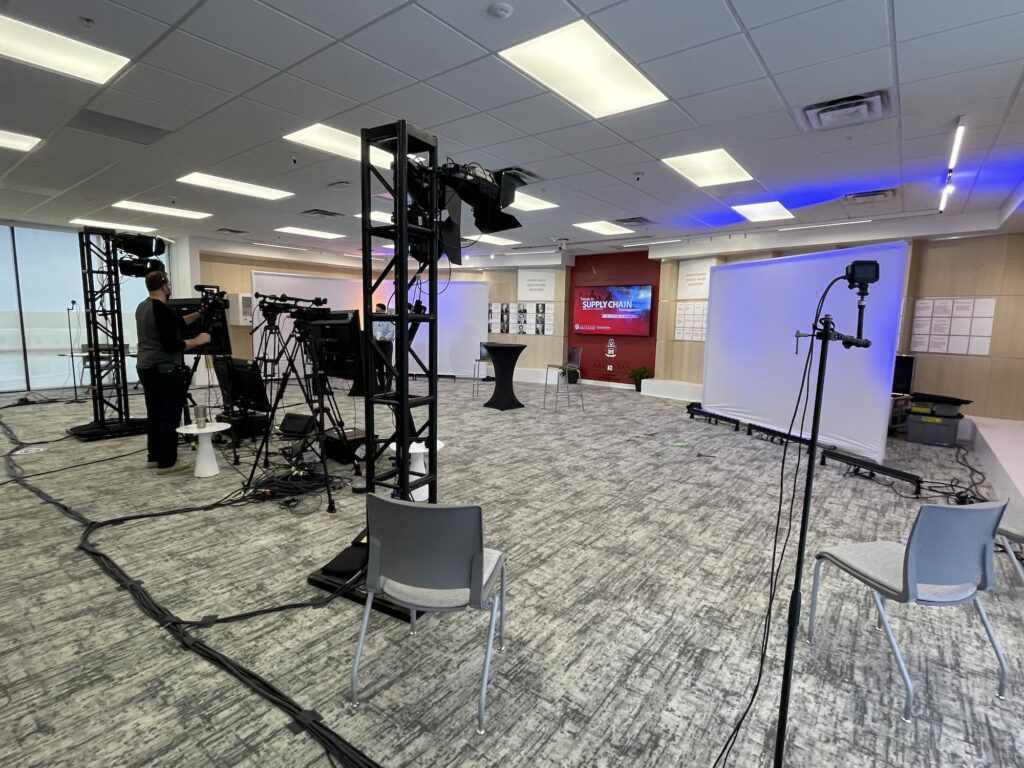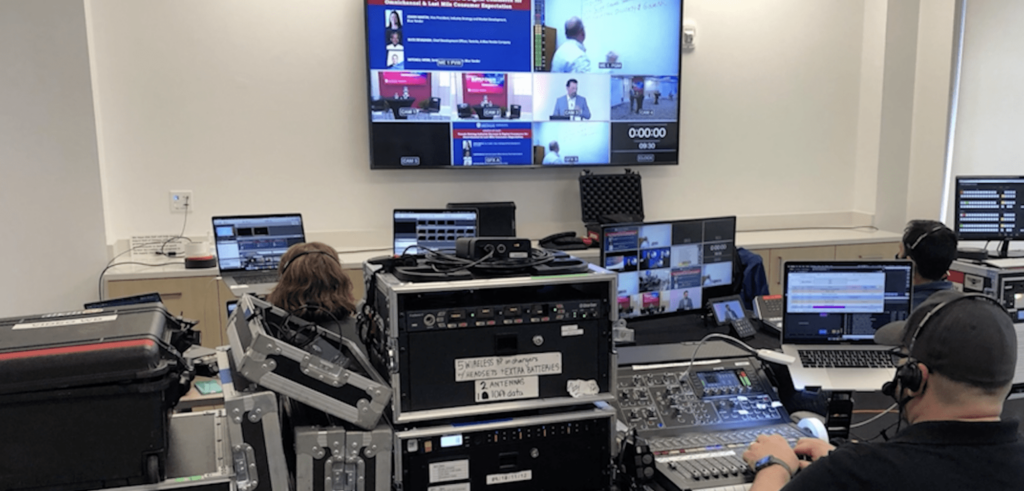We just wrapped up the Trends in Supply Chain conference for the University of Arkansas Walton College of Business. We’d love to share some of the client’s key learnings from this project in hopes that you can learn alongside them for your upcoming event.
Their event was a virtual event that we hosted on-site from their facility. We moved our Master Control Room from our facility to theirs. At the venue, we built out some of our audio, video, and lighting systems. For video, our switcher took all the video sources and switched them for the final broadcast to folks at home. Those video sources included PowerPoint graphics, slideshows, sponsor logos, on-screen graphics as lower-third nameplates with titles, and more. We had a video playback machine for all the video clips, commercials, and pre-recorded presentations the client had lined up for their four-day agenda.
Not only did we broadcast out our video signal, but we also streamed into our facility’s remote presenter feeds. This allowed presenters who were not able to travel to be in-person the ability to present from home. We received their video and audio feeds, switched and mixed them, and then re-streamed those out to the world from our control room.
For audio, we had microphones for each of the in-person presenters. We also gave them their own speakers so they could hear back things like videos. More than that, we built mix-minuses so they could have bi-directional conversations on-camera with remote presenters, allowing seamless Q&A. We also recorded everything locally just in case of an internet failure, we would have been able to post the show online for attendees to catch up on a delayed timetable.
Beyond our Master Control area, we also built out a simple studio environment for their in-person presenters to speak from. The facility already had good bones for in-person meetings, it just needed to have us prepare it to be on-camera. To make the conference flow most smoothly, we divided the presentation areas into three zones. This left, center, and right area allowed their moderator host to be on the left, solo presenters on the right, and a center area for any fireside chats between multiple people.

We love production, we’re here to make the complex technical components of event planning simple. However, we take planning really seriously, and often in planning it is our expertise from doing hundreds of events that inform our client’s decisions in the biggest ways. One of the “non-technical” ways we advised during planning was to have our client’s boss, Donnie, be the moderator on-screen and available at all times during the conference. With a multi-year event like this, attendees really grow to trust the consistent face of leadership. We equipped Donnie to moderate Q&A live from his laptop, gave him a teleprompter to speak from, his own microphone and camera, and really set him up to look his best at all times. He was the rock that drove the conference from our standpoint and the audiences. By equipping him in this way, no matter what happened, we knew we could cut to Donnie and he would be informed about how to get things back on schedule.
There are so many variables and “Plan B” moments that go into events. In-person events, virtual events, and now hybrid events, all have thousands of things that could go wrong. Not every budget can afford triple redundancy of systems, and at a certain point, things like attendee internet connections are just out of your control. What we strive to do is create ecosystems, like setting up Donnie as the host, that allows for things to be flexible and to pivot live in the moment, rather than dumping to a “please standby” slide or having a jarring lack of communication to your attendees when a session runs long or ends early.
Attendee engagement has been a hot topic in planning virtual events, and nothing kills engagement like an absence of communication from leadership. Set your leaders up to succeed by equipping them with tools just like we equipped Donnie. It’s about more than making them “look good” for the show, it’s about the brand trust that your attendees have built with your organization for years, and keeping that in critical moments when everyone is watching.
Organizations have pivoted and innovated from the pandemic, learning how to host their own webinars. This event, their biggest day of the year, deserved to be more than that. Attendees have adjusted their standards from a bombardment of Zoom video calls, but for an annual conference, it deserves a level of polish to rise above the monthly standards.

Two Huge Wins
Gaining Attendees from Around the World
This was a huge feature for this client. Not only would attendees have not been able to travel due to the pandemic, but even in a “normal” year, the cost of international travel would certainly limit the number of attendees. Changing to a streaming broadcast, in this case, a virtual event but perhaps in the future a hybrid event, allowed the reach of the content to go further.
Retaining Attendees with Busy Schedules
Event audiences are about more than quantity, it’s about quality. The higher caliber of talent you have in your audience, likely the busier their schedules are going to be. Limiting events to in-person audiences constrains attendees to have to dedicate a day of travel before/after the conference, as well as tying them up “out of office” and away for days. By allowing busy attendees to tune in from their offices, our client retained top-tier talent for the majority of the conference, keeping those subscribers engaged and bought-in to the long-term commitment to the organization.
We hope you enjoyed getting a look around this recent event. Our heart is that you could learn what this client learned from working with us and that you could apply it to your upcoming event.
